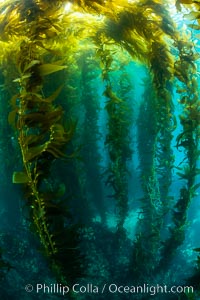
The Kelp Forest of San Clemente Island, California. A kelp forest. Giant kelp grows rapidly, up to 2' per day, from the rocky reef on the ocean bottom to which it is anchored, toward the ocean surface where it spreads to form a thick canopy. Myriad species of fishes, mammals and invertebrates form a rich community in the kelp forest. Lush forests of kelp are found throughout California's Southern Channel Islands.
Species: Giant kelp, Macrocystis pyrifera
Location: San Clemente Island, California
Image ID: 34614
Species: Giant kelp, Macrocystis pyrifera
Location: San Clemente Island, California
Image ID: 34614
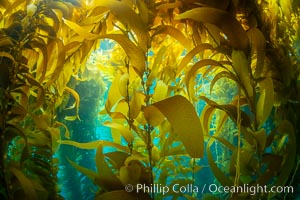
The Kelp Forest of San Clemente Island, California. A kelp forest. Giant kelp grows rapidly, up to 2' per day, from the rocky reef on the ocean bottom to which it is anchored, toward the ocean surface where it spreads to form a thick canopy. Myriad species of fishes, mammals and invertebrates form a rich community in the kelp forest. Lush forests of kelp are found throughout California's Southern Channel Islands.
Species: Giant kelp, Macrocystis pyrifera
Location: San Clemente Island, California
Image ID: 34615
Species: Giant kelp, Macrocystis pyrifera
Location: San Clemente Island, California
Image ID: 34615
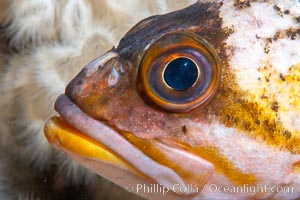
Rockfish, Browning Pass, Vancouver Island, Canada.
Location: British Columbia, Canada
Image ID: 35375
Location: British Columbia, Canada
Image ID: 35375
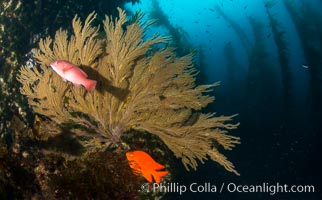
California golden gorgonian, Garibaldi and Sheephead wrasse fishes on rocky reef, below kelp forest, underwater. The golden gorgonian is a filter-feeding temperate colonial species that lives on the rocky bottom at depths between 50 to 200 feet deep. Each individual polyp is a distinct animal, together they secrete calcium that forms the structure of the colony. Gorgonians are oriented at right angles to prevailing water currents to capture plankton drifting by.
Species: California golden gorgonian, California sheephead wrasse, Garibaldi, Hypsypops rubicundus, Muricea californica, Semicossyphus pulcher
Location: San Clemente Island, California
Image ID: 30922
Species: California golden gorgonian, California sheephead wrasse, Garibaldi, Hypsypops rubicundus, Muricea californica, Semicossyphus pulcher
Location: San Clemente Island, California
Image ID: 30922
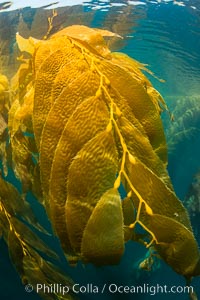
The Kelp Forest offshore of La Jolla, California. A kelp forest. Giant kelp grows rapidly, up to 2' per day, from the rocky reef on the ocean bottom to which it is anchored, toward the ocean surface where it spreads to form a thick canopy. Myriad species of fishes, mammals and invertebrates form a rich community in the kelp forest. Lush forests of kelp are found throughout California's Southern Channel Islands.
Species: Giant kelp, Macrocystis pyrifera
Location: La Jolla, California
Image ID: 30989
Species: Giant kelp, Macrocystis pyrifera
Location: La Jolla, California
Image ID: 30989
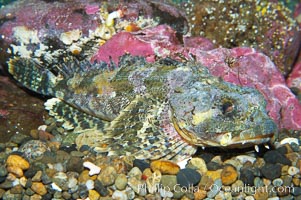
Red Irish Lord. The red irish lord lurks in shallow habitats where it feeds on crabs, shrimp, barnacles, mussels and small fishes.
Species: Red irish lord, Hemilepidotus hemilepidotus
Image ID: 13689
Species: Red irish lord, Hemilepidotus hemilepidotus
Image ID: 13689
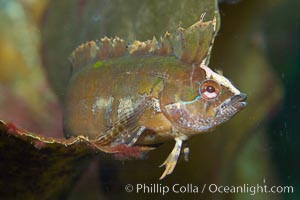
Crevice rockfish. Seldom seen, kelpfish hover among the seaweeds in wave swept tidepools and reefs. These secretive fish rapidly change color to match watever background they are near. This kelpfish has assumed the coloration of the blade of kelp it is resting on.
Species: Crevice rockfish, Gibbonsia montereyensis
Location: Monterey, California
Image ID: 13711
Species: Crevice rockfish, Gibbonsia montereyensis
Location: Monterey, California
Image ID: 13711
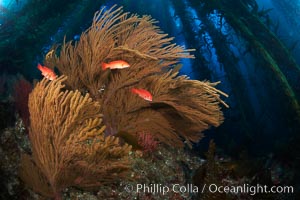
California golden gorgonian and small juvenile sheephead fishes on rocky reef, below kelp forest, underwater. The golden gorgonian is a filter-feeding temperate colonial species that lives on the rocky bottom at depths between 50 to 200 feet deep. Each individual polyp is a distinct animal, together they secrete calcium that forms the structure of the colony. Gorgonians are oriented at right angles to prevailing water currents to capture plankton drifting by.
Species: California golden gorgonian, Muricea californica, Semicossyphus pulcher
Location: San Clemente Island, California
Image ID: 23421
Species: California golden gorgonian, Muricea californica, Semicossyphus pulcher
Location: San Clemente Island, California
Image ID: 23421
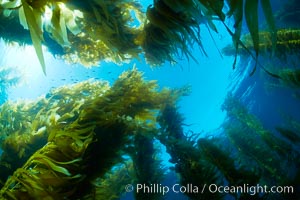
Giant kelp plants lean over in ocean currents, underwater. Individual kelp plants grow from the rocky reef, to which they are attached, up to the ocean surface and form a vibrant community in which fishes, mammals and invertebrates thrive.
Species: Giant kelp, Macrocystis pyrifera
Location: San Clemente Island, California
Image ID: 23426
Species: Giant kelp, Macrocystis pyrifera
Location: San Clemente Island, California
Image ID: 23426
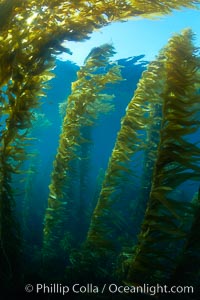
A kelp forest. Giant kelp grows rapidly, up to 2' per day, from the rocky reef on the ocean bottom to which it is anchored, toward the ocean surface where it spreads to form a thick canopy. Myriad species of fishes, mammals and invertebrates form a rich community in the kelp forest. Lush forests of kelp are found through California's Southern Channel Islands.
Species: Giant kelp, Macrocystis pyrifera
Location: San Clemente Island, California
Image ID: 23428
Species: Giant kelp, Macrocystis pyrifera
Location: San Clemente Island, California
Image ID: 23428
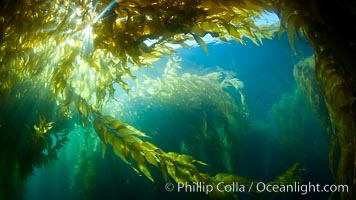
A view of an underwater forest of giant kelp. Giant kelp grows rapidly, up to 2' per day, from the rocky reef on the ocean bottom to which it is anchored, toward the ocean surface where it spreads to form a thick canopy. Myriad species of fishes, mammals and invertebrates form a rich community in the kelp forest. Lush forests of kelp are found through California's Southern Channel Islands.
Species: Giant kelp, Macrocystis pyrifera
Location: San Clemente Island, California
Image ID: 25400
Species: Giant kelp, Macrocystis pyrifera
Location: San Clemente Island, California
Image ID: 25400
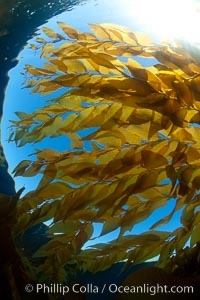
A view of an underwater forest of giant kelp. Giant kelp grows rapidly, up to 2' per day, from the rocky reef on the ocean bottom to which it is anchored, toward the ocean surface where it spreads to form a thick canopy. Myriad species of fishes, mammals and invertebrates form a rich community in the kelp forest. Lush forests of kelp are found through California's Southern Channel Islands.
Species: Giant kelp, Macrocystis pyrifera
Location: San Clemente Island, California
Image ID: 25432
Species: Giant kelp, Macrocystis pyrifera
Location: San Clemente Island, California
Image ID: 25432
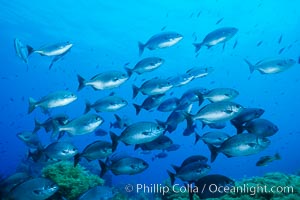
Cortez chubb.
Species: Cortez chubb, Kyphosus elegans
Location: Guadalupe Island (Isla Guadalupe), Baja California, Mexico
Image ID: 01020
Species: Cortez chubb, Kyphosus elegans
Location: Guadalupe Island (Isla Guadalupe), Baja California, Mexico
Image ID: 01020
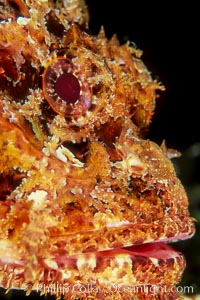
Stone scorpionfish.
Species: Pacific spotted scorpionfish, Scorpaena mystes
Location: Wolf Island, Galapagos Islands, Ecuador
Image ID: 02568
Species: Pacific spotted scorpionfish, Scorpaena mystes
Location: Wolf Island, Galapagos Islands, Ecuador
Image ID: 02568
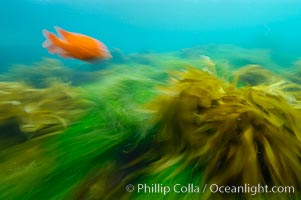
A garibaldi fish (orange), surf grass (green) and palm kelp (brown) on the rocky reef -- all appearing blurred in this time exposure -- are tossed back and forth by powerful ocean waves passing by above. San Clemente Island.
Species: Surfgrass, Hypsypops rubicundus, Phyllospadix
Location: San Clemente Island, California
Image ID: 10238
Species: Surfgrass, Hypsypops rubicundus, Phyllospadix
Location: San Clemente Island, California
Image ID: 10238
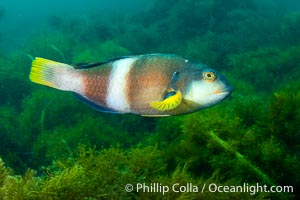
Bluethroat Wrasse, Notolabrus tetricus, Adult Male, Kangaroo Island, South Australia.
Species: Bluethroat Wrasse, Notolabrus tetricus
Location: Kangaroo Island, South Australia
Image ID: 39227
Species: Bluethroat Wrasse, Notolabrus tetricus
Location: Kangaroo Island, South Australia
Image ID: 39227
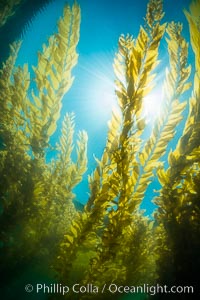
The Kelp Forest offshore of La Jolla, California. A kelp forest. Giant kelp grows rapidly, up to 2' per day, from the rocky reef on the ocean bottom to which it is anchored, toward the ocean surface where it spreads to form a thick canopy. Myriad species of fishes, mammals and invertebrates form a rich community in the kelp forest. Lush forests of kelp are found through California's Southern Channel Islands.
Species: Giant kelp, Macrocystis pyrifera
Location: La Jolla, California
Image ID: 30995
Species: Giant kelp, Macrocystis pyrifera
Location: La Jolla, California
Image ID: 30995
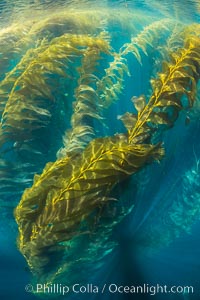
The Kelp Forest offshore of La Jolla, California. A kelp forest. Giant kelp grows rapidly, up to 2' per day, from the rocky reef on the ocean bottom to which it is anchored, toward the ocean surface where it spreads to form a thick canopy. Myriad species of fishes, mammals and invertebrates form a rich community in the kelp forest. Lush forests of kelp are found through California's Southern Channel Islands.
Species: Giant kelp, Macrocystis pyrifera
Location: La Jolla, California
Image ID: 30996
Species: Giant kelp, Macrocystis pyrifera
Location: La Jolla, California
Image ID: 30996
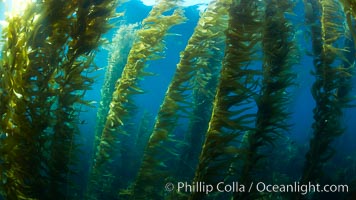
A kelp forest. Giant kelp grows rapidly, up to 2' per day, from the rocky reef on the ocean bottom to which it is anchored, toward the ocean surface where it spreads to form a thick canopy. Myriad species of fishes, mammals and invertebrates form a rich community in the kelp forest. Lush forests of kelp are found through California's Southern Channel Islands.
Species: Giant kelp, Macrocystis pyrifera
Location: San Clemente Island, California
Image ID: 23455
Species: Giant kelp, Macrocystis pyrifera
Location: San Clemente Island, California
Image ID: 23455
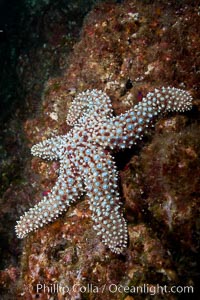
A giant sea star, or starfish, on a rocky reef underwater.
Species: Giant sea star, Pisaster giganteus
Location: San Clemente Island, California
Image ID: 25410
Species: Giant sea star, Pisaster giganteus
Location: San Clemente Island, California
Image ID: 25410
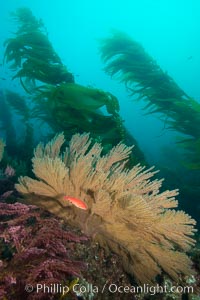
California golden gorgonian and small juvenile sheephead fishes on rocky reef, below kelp forest, underwater. The golden gorgonian is a filter-feeding temperate colonial species that lives on the rocky bottom at depths between 50 to 200 feet deep. Each individual polyp is a distinct animal, together they secrete calcium that forms the structure of the colony. Gorgonians are oriented at right angles to prevailing water currents to capture plankton drifting by.
Species: California sheephead wrasse, Semicossyphus pulcher
Location: San Clemente Island, California
Image ID: 30903
Species: California sheephead wrasse, Semicossyphus pulcher
Location: San Clemente Island, California
Image ID: 30903
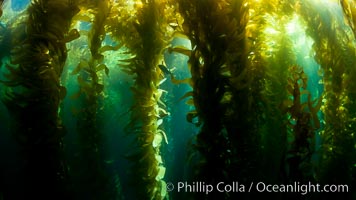
A view of an underwater forest of giant kelp. Giant kelp grows rapidly, up to 2' per day, from the rocky reef on the ocean bottom to which it is anchored, toward the ocean surface where it spreads to form a thick canopy. Myriad species of fishes, mammals and invertebrates form a rich community in the kelp forest. Lush forests of kelp are found through California's Southern Channel Islands.
Species: Giant kelp, Macrocystis pyrifera
Location: San Clemente Island, California
Image ID: 25402
Species: Giant kelp, Macrocystis pyrifera
Location: San Clemente Island, California
Image ID: 25402
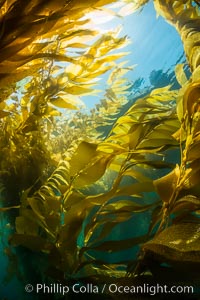
The Kelp Forest offshore of La Jolla, California. A kelp forest. Giant kelp grows rapidly, up to 2' per day, from the rocky reef on the ocean bottom to which it is anchored, toward the ocean surface where it spreads to form a thick canopy. Myriad species of fishes, mammals and invertebrates form a rich community in the kelp forest. Lush forests of kelp are found throughout California's Southern Channel Islands.
Species: Giant kelp, Macrocystis pyrifera
Location: La Jolla, California
Image ID: 30998
Species: Giant kelp, Macrocystis pyrifera
Location: La Jolla, California
Image ID: 30998
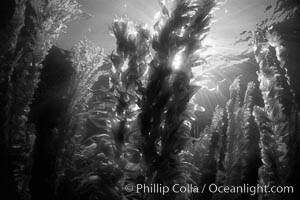
A kelp forest. Giant kelp grows rapidly, up to 2' per day, from the rocky reef on the ocean bottom to which it is anchored, toward the ocean surface where it spreads to form a thick canopy. Myriad species of fishes, mammals and invertebrates form a rich community in the kelp forest. Lush forests of kelp are found through California's Southern Channel Islands.
Species: Giant kelp, Macrocystis pyrifera
Location: San Clemente Island, California
Image ID: 23435
Species: Giant kelp, Macrocystis pyrifera
Location: San Clemente Island, California
Image ID: 23435
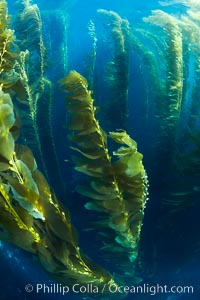
A kelp forest. Giant kelp grows rapidly, up to 2' per day, from the rocky reef on the ocean bottom to which it is anchored, toward the ocean surface where it spreads to form a thick canopy. Myriad species of fishes, mammals and invertebrates form a rich community in the kelp forest. Lush forests of kelp are found through California's Southern Channel Islands.
Species: Giant kelp, Macrocystis pyrifera
Location: San Clemente Island, California
Image ID: 23446
Species: Giant kelp, Macrocystis pyrifera
Location: San Clemente Island, California
Image ID: 23446
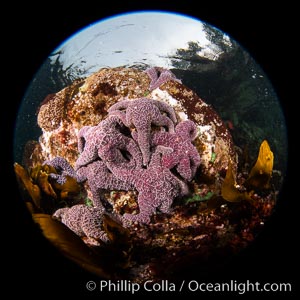
Starfish cling to a rocky reef, surrounded by other colorful invertebrate life. Browning Pass, Vancouver Island.
Location: British Columbia, Canada
Image ID: 35425
Location: British Columbia, Canada
Image ID: 35425
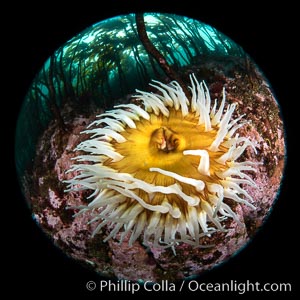
The Fish Eating Anemone Urticina piscivora, a large colorful anemone found on the rocky underwater reefs of Vancouver Island, British Columbia.
Species: Fish-eating anemone, Urticina piscivora
Location: British Columbia, Canada
Image ID: 35427
Species: Fish-eating anemone, Urticina piscivora
Location: British Columbia, Canada
Image ID: 35427
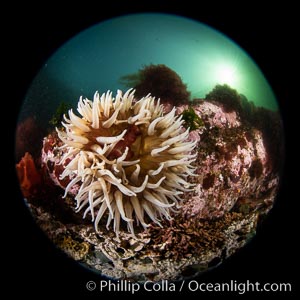
The Fish Eating Anemone Urticina piscivora, a large colorful anemone found on the rocky underwater reefs of Vancouver Island, British Columbia.
Species: Fish-eating anemone, Urticina piscivora
Location: British Columbia, Canada
Image ID: 35431
Species: Fish-eating anemone, Urticina piscivora
Location: British Columbia, Canada
Image ID: 35431
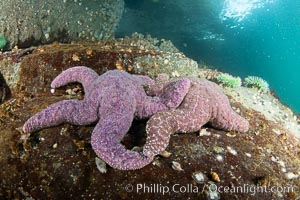
Starfish cling to a rocky reef, surrounded by other colorful invertebrate life. Browning Pass, Vancouver Island.
Location: British Columbia, Canada
Image ID: 35438
Location: British Columbia, Canada
Image ID: 35438
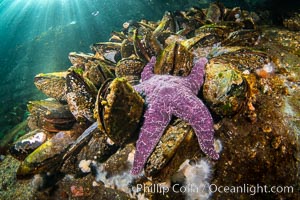
Starfish cling to a rocky reef, surrounded by other colorful invertebrate life. Browning Pass, Vancouver Island.
Location: British Columbia, Canada
Image ID: 35441
Location: British Columbia, Canada
Image ID: 35441